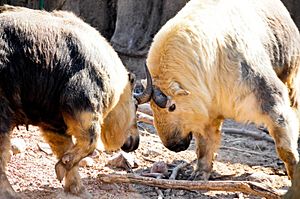Aggression facts for kids

Aggression is overt or covert, often harmful, social interaction with the intention of inflicting damage or other unpleasantness upon another individual. It may occur either re-actively or without provocation. In humans, frustration due to blocked goals can cause aggression. Human aggression can be classified into direct and indirect aggression; whilst the former is characterized by physical or verbal behavior intended to cause harm to someone, the latter is characterized by behavior intended to harm the social relations of an individual or group.
In definitions commonly used in the social sciences and behavioral sciences, aggression is an action or response by an individual that delivers something unpleasant to another person. Some definitions include that the individual must intend to harm another person.
Aggression can take a variety of forms, which may be expressed physically, or communicated verbally or non-verbally: including anti-predator aggression, defensive aggression (fear-induced), predatory aggression, dominance aggression, inter-male aggression, resident-intruder aggression, maternal aggression, species-specific aggression, territorial aggression, isolation-induced aggression, irritable aggression, and brain-stimulation-induced aggression (hypothalamus).
There are two subtypes of human aggression:
- (1) controlled-instrumental subtype (purposeful or goal-oriented)
- (2) reactive-impulsive subtype (often elicits uncontrollable actions that are inappropriate or undesirable)
Reactive relational aggression (hostile, affective, retaliatory) is used in response to feeling attacked, threatened, or mad. Usually the person who exhibits this type of aggression feels provoked to do so. Instrumental relational aggression (predatory, goal-oriented) is used in order for an individual to get what they want.
Gender plays an important role in human aggression. There are multiple theories that seek to explain findings that males and females of the same species can have differing aggressive behaviors. However, the conditions under which women and men differ in aggressiveness are not well understood or studied.
Many researchers focus on the brain to explain aggression. The role of the chemicals in the brain, particularly neurotransmitters, in aggression has also been examined.
Animals
Like most, or even all behaviors, aggression can be examined in terms of its ability to help an animal reproduce and survive. Animals may use aggression to gain and secure territories, as well as other resources including food, water, and mating opportunities.
The most apparent type of aggression is that seen in the interaction between a predator and its prey. An animal defending itself against a predator becomes aggressive in order to survive and predator in order to secure food.
Because aggression against a much larger enemy or group of enemies would be nearly certain to lead to the death of an animal, animals have developed a good sense of when they are outnumbered. This ability to gauge the strength of other animals gives animals a "fight or flight" response to predators; depending on how strong they gauge the predator to be, animals will either become aggressive or flee.
Images for kids
-
Two warthogs preparing to fight
See also
 In Spanish: Agresión para niños
In Spanish: Agresión para niños




